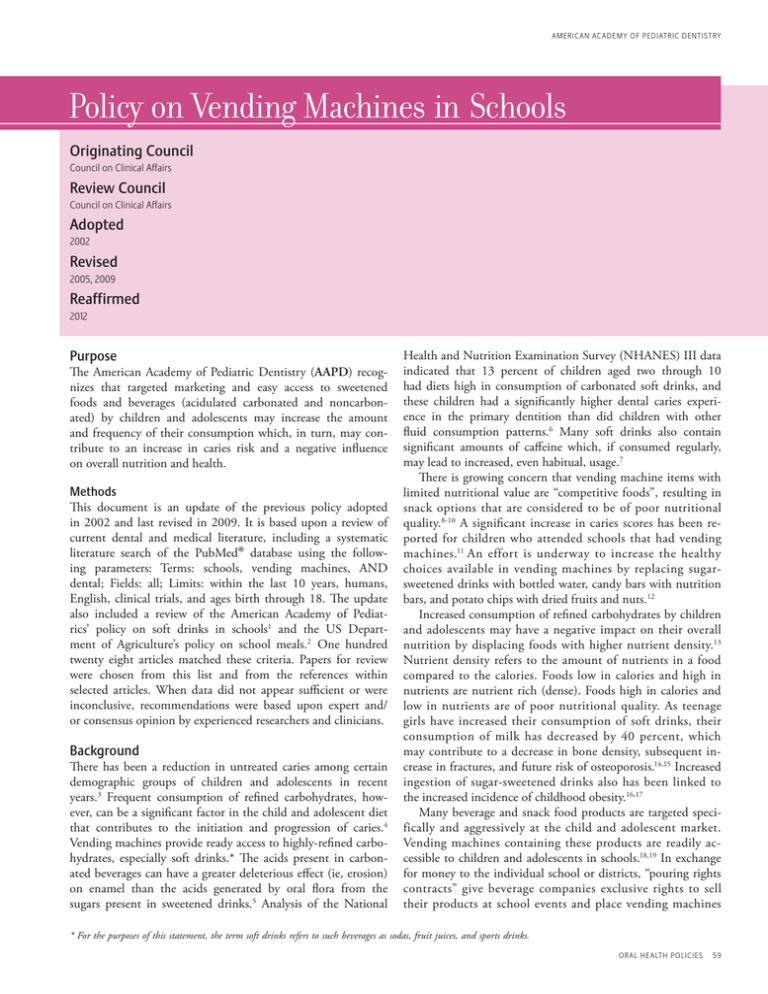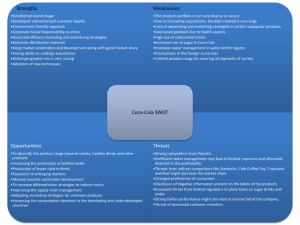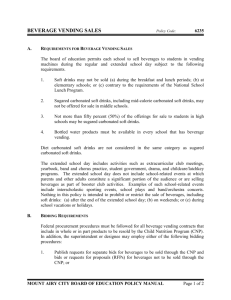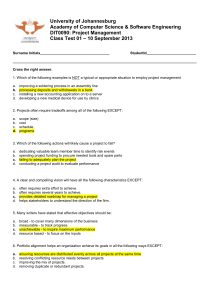Originating Council Review Council Adopted
advertisement

AMERICAN ACADEMY OF PEDIATRIC DENTISTRY Policy on Vending Machines in Schools Originating Council Council on Clinical Affairs Review Council Council on Clinical Affairs Adopted 2002 Revised 2005, 2009 Reaffirmed 2012 Purpose The American Academy of Pediatric Dentistry (AAPD) recognizes that targeted marketing and easy access to sweetened foods and beverages (acidulated carbonated and noncarbonated) by children and adolescents may increase the amount and frequency of their consumption which, in turn, may contribute to an increase in caries risk and a negative influence on overall nutrition and health. Methods This document is an update of the previous policy adopted in 2002 and last revised in 2009. It is based upon a review of current dental and medical literature, including a systematic literature search of the PubMed® database using the following parameters: Terms: schools, vending machines, AND dental; Fields: all; Limits: within the last 10 years, humans, English, clinical trials, and ages birth through 18. The update also included a review of the American Academy of Pediatrics’ policy on soft drinks in schools1 and the US Department of Agriculture’s policy on school meals.2 One hundred twenty eight articles matched these criteria. Papers for review were chosen from this list and from the references within selected articles. When data did not appear sufficient or were inconclusive, recommendations were based upon expert and/ or consensus opinion by experienced researchers and clinicians. Background There has been a reduction in untreated caries among certain demographic groups of children and adolescents in recent years.3 Frequent consumption of refined carbohydrates, however, can be a significant factor in the child and adolescent diet that contributes to the initiation and progression of caries.4 Vending machines provide ready access to highly-refined carbohydrates, especially soft drinks.* The acids present in carbonated beverages can have a greater deleterious effect (ie, erosion) on enamel than the acids generated by oral flora from the sugars present in sweetened drinks.5 Analysis of the National Health and Nutrition Examination Survey (NHANES) III data indicated that 13 percent of children aged two through 10 had diets high in consumption of carbonated soft drinks, and these children had a significantly higher dental caries experience in the primary dentition than did children with other fluid consumption patterns.6 Many soft drinks also contain significant amounts of caffeine which, if consumed regularly, may lead to increased, even habitual, usage.7 There is growing concern that vending machine items with limited nutritional value are “competitive foods”, resulting in snack options that are considered to be of poor nutritional quality.8-10 A significant increase in caries scores has been reported for children who attended schools that had vending machines.11 An effort is underway to increase the healthy choices available in vending machines by replacing sugarsweetened drinks with bottled water, candy bars with nutrition bars, and potato chips with dried fruits and nuts.12 Increased consumption of refined carbohydrates by children and adolescents may have a negative impact on their overall nutrition by displacing foods with higher nutrient density.13 Nutrient density refers to the amount of nutrients in a food compared to the calories. Foods low in calories and high in nutrients are nutrient rich (dense). Foods high in calories and low in nutrients are of poor nutritional quality. As teenage girls have increased their consumption of soft drinks, their consumption of milk has decreased by 40 percent, which may contribute to a decrease in bone density, subsequent increase in fractures, and future risk of osteoporosis.14,15 Increased ingestion of sugar-sweetened drinks also has been linked to the increased incidence of childhood obesity.16,17 Many beverage and snack food products are targeted specifically and aggressively at the child and adolescent market. Vending machines containing these products are readily accessible to children and adolescents in schools.18,19 In exchange for money to the individual school or districts, “pouring rights contracts” give beverage companies exclusive rights to sell their products at school events and place vending machines * For the purposes of this statement, the term soft drinks refers to such beverages as sodas, fruit juices, and sports drinks. ORAL HE ALTH POLICIES 59 REFERENCE MANUAL V 37 / NO 6 15 / 16 on school property, along with other measures that increase student exposure to the beverages.20 Presently, several states have legislation and others are considering legislation to limit pouring rights contracts to healthier options.21-24 Policy statement The AAPD: • Encourages collaboration with other dental and medical organizations, governmental agencies, education officials, parent and consumer groups, and corporations to increase public awareness of the negative effects of frequent and/or inappropriate intake of sweetened drinks (carbonated and noncarbonated) and low nutrient dense snack foods on infant, child, and adolescent oral health, nutrition, and general health. • Opposes any arrangements that may decrease access to healthy nutritional choices for children and adolescents. • Encourages school officials and parent groups to consider the importance of maintaining healthy choices in vending machines in schools and encourages the promotion of food and beverages of high nutritional value; bottled water and other more healthy choices should be available instead of soft drinks. • Promotes educating and informing the public about the importance of good oral hygiene and nutritional habits as they pertain to consumption of items available in vending machines. References 1. American Academy of Pediatrics Committee on School Health. Policy statement: Soft drinks in schools. Pediatrics 2004;113(1Pt+1):152-4. Reaffirmed December, 2008. 2. US Dept of Agriculture Food and Nutrition Service. National School Lunch Program. Available at: “http://www. fns.usda.gov/cnd/Lunch/”. Accessed June 24, 2012. 3. Brown LJ, Wall TP, Lazar V. Trends in total caries experience: Permanent and primary teeth. J Am Dent Assoc 2000;131(2):223-31. 4. Ismail IA, Burt BA, Eklund SA. The cariogenicity of soft drinks in the United States. J Am Dent Assoc 1984;109 (2):241-5. 5. Joint Report of the American Dental Association Council on Access, Prevention, and Interprofessional Relations and Council on Scientific Affairs to the House of Delegates. Response to Resolution 73H-2000. Chicago, Ill: ADA; October 2001. 6. Sohn W, Burt BA, Sowers MR. Carbonated soft drinks and dental caries in the primary dentition. J Dent Res 2006;85(3):262-6. 7. Majewski R. Dental caries in adolescents associated with caffeinated carbonated beverages. Pediatr Dent 2001;23 (3):198-203. 8.US Government Accountability Office. Report to Congressional Requests: School Meal Programs Competitive Foods are Widely Available and Generate Substantial Revenues for Schools. August 2005. Available at: “http://www. gao.gov/new.items/d05563.pdf ”. Accessed June 24, 2012. 60 ORAL HE ALTH POLICIES 9. Kakarala M, Keast DR, Hoerr S. Schoolchildren’s consumption of competitive foods and beverages, excluding à la carte. J Sch Health 2010;80(9):429-35. 10. Pasch KE, Lytle LA, Samuelson AC, Farbakhsh K, Kubik MY, Patnode CD. Are school vending machines loaded with calories and fat: an assessment of 106 middle and high schools. J Sch Health 2011;81(4):212-8. 11. Maliderou M, Reeves S, Nobel C. The effect of social demographic factors, snack consumption, and vending machine use on oral health of children living in London. British Dent J 2006;201(7):441-4. 12. US Dept of Agriculture Food and Nutrition Service Office of Analysis, Nutrition, and Evaluation. National School Lunch Program Competitive Food Policies by State. Available at: “http://www.usda.gov/wps/portal/usda/usda home?contentidonly=true&contentid=2011/01/0010.xml”. Accessed July 10, 2012. 13. Freeman R, Sheiham A. Understanding decision-making processes for sugar consumption in adolescence. Community Dent Oral Epidemiol 1997;25(3):228-32. 14. Wyshak G. Teenaged girls, carbonated beverage consumption, and bone fractures. Arch Pediatr Adolesc Med 2000;154(6):610-3. 15. Ludwig DS, Peterson KE, Gortmaker SL. Relation between consumption of sugar-sweetened drinks and childhood obesity: A prospective, observational analysis. Lancet 2001;357(9255):505-8. 16. Fox K. Soft drinks under scrutiny. ADA News November 20; 2000:22. 17. Fox MK, Dodd AH Wilson A, Gleason PM. Association between school food environment and practices and body mass index of US public school children. J Am Diet Assoc 2009;109(2Suppl):S108-17. 18. Rovner AJ, Nansel TR, Wang J, Iannotti RJ. Food sold in school vending machines is associated with overall student dietary intake. J Adolesc Health 2011;48(1):13-9. 19. Turner L, Chaloupka F. Wide availability of high-calorie beverages in US elementary schools. Arch Pediatr Adolesc Med 2011;165(3):223-8. 20. Maihofer M. “Pouring wrongs”: MDA discourages pop deals. J Mich Dent Assoc 2000;82(2):10. 21. Berthold M. Michigan opposes school-soda deals. ADA News November 20, 2000:8. 22. National Council of State Legislatures. Vending machines in schools 2005. Available at: “http://www.ncsl.org/Issues Research/Health/VendingMachinesinSchools2005/tabid/ 14108/Default.aspx”. Accessed June 24, 2012. 23. Kubik MY, Lytle LA, Farbakhsh K. School and district wellness councils and availability of low-nutrient, energydense vending fare in Minnesota middle and high schools. J Am Diet Assoc 2011;111(1):150-5. 24. Whatley Blum JE, Beaudoin CM, O’Brien LM, Polacsek M, Harris D, O’Rourke KA. Impact of Maine’s statewide nutrition policy on high school food environments. Prev Chronic Dis 2011;8(1):A19.



